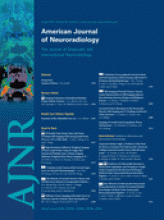Research ArticleInterventional
Open Access
Influence of Hemodynamic Factors on Rupture of Intracranial Aneurysms: Patient-Specific 3D Mirror Aneurysms Model Computational Fluid Dynamics Simulation
G. Lu, L. Huang, X.L. Zhang, S.Z. Wang, Y. Hong, Z. Hu and D.Y. Geng
American Journal of Neuroradiology August 2011, 32 (7) 1255-1261; DOI: https://doi.org/10.3174/ajnr.A2461
G. Lu
L. Huang
X.L. Zhang
S.Z. Wang
Y. Hong
Z. Hu

References
- 1.↵
- Winn HR,
- Jane JA,
- Taylor J,
- et al
- 2.↵
- Rinkel GJ,
- Djibuti M,
- Algra A,
- et al
- 3.↵
Unruptured intracranial aneurysms: risk of rupture and risks of surgical intervention—International Study of Unruptured Intracranial Aneurysms Investigators. N Engl J Med 1998;339:1725–33. Erratum in: N Engl J Med 1999;340:744
- 4.↵
- Ujiie H,
- Tachibana H,
- Hiramatsu O,
- et al
- 5.↵
- Weir B,
- Amidei C,
- Kongable G,
- et al
- 6.↵
- Malek AM,
- Alper SL,
- Izumo S
- 7.↵
- Valencia A,
- Zarate A,
- Galvez M,
- et al
- 8.↵
- He X,
- Ku DN
- 9.↵
- Kaminogo M,
- Yonekura M,
- Shibata S
- 10.↵
- Juvela S
- 11.↵
- 12.↵
- 13.↵
- Cebral JR,
- Castro MA,
- Burgess JE,
- et al
- 14.↵
- 15.↵
- 16.↵
- Shojima M,
- Oshima M,
- Takagi K,
- et al
- 17.↵
- 18.↵
- Kataoka K,
- Taneda M,
- Asai T,
- et al
- 19.↵
- Dardik A,
- Chen L,
- Frattini J,
- et al
- 20.↵
- Radaelli AG,
- Sola T,
- Vivas E,
- et al
- 21.↵
- Himburg HA,
- Grzybowski DM,
- Hazel AL,
- et al
- 22.↵
- Ziegler T,
- Bouzourène K,
- Harrison VJ,
- et al
- 23.↵
- Mollnau H,
- Wendt M,
- Szocs K,
- et al
- 24.↵
- Nickenig G,
- Harrison DG
- 25.↵
- Bia D,
- Zócalo Y,
- Armentano R,
- et al
- 26.↵
- Tremmel M,
- Dhar S,
- Levy EI,
- et al
- 27.↵
In this issue
Advertisement
G. Lu, L. Huang, X.L. Zhang, S.Z. Wang, Y. Hong, Z. Hu, D.Y. Geng
Influence of Hemodynamic Factors on Rupture of Intracranial Aneurysms: Patient-Specific 3D Mirror Aneurysms Model Computational Fluid Dynamics Simulation
American Journal of Neuroradiology Aug 2011, 32 (7) 1255-1261; DOI: 10.3174/ajnr.A2461
0 Responses
Influence of Hemodynamic Factors on Rupture of Intracranial Aneurysms: Patient-Specific 3D Mirror Aneurysms Model Computational Fluid Dynamics Simulation
G. Lu, L. Huang, X.L. Zhang, S.Z. Wang, Y. Hong, Z. Hu, D.Y. Geng
American Journal of Neuroradiology Aug 2011, 32 (7) 1255-1261; DOI: 10.3174/ajnr.A2461
Jump to section
Related Articles
- No related articles found.
Cited By...
- Intracranial Aneurysm Wall Displacement Predicts Instability
- Morphology parameters for rupture in middle cerebral artery mirror aneurysms
- Hemodynamic characteristics of stable and unstable vertebrobasilar dolichoectatic and fusiform aneurysms
- Selection of helical braided flow diverter stents based on hemodynamic performance and mechanical properties
- Hemodynamic differences between unstable and stable unruptured aneurysms independent of size and location: a pilot study
- Hemodynamic-morphological discriminant models for intracranial aneurysm rupture remain stable with increasing sample size
- Rupture Resemblance Score (RRS): toward risk stratification of unruptured intracranial aneurysms using hemodynamic-morphological discriminants
- Quantitative comparison of hemodynamic parameters from steady and transient CFD simulations in cerebral aneurysms with focus on the aneurysm ostium
- CFD: Computational Fluid Dynamics or Confounding Factor Dissemination? The Role of Hemodynamics in Intracranial Aneurysm Rupture Risk Assessment
- Wall Shear Stress Distribution of Small Aneurysms Prone to Rupture: A Case-Control Study
This article has been cited by the following articles in journals that are participating in Crossref Cited-by Linking.
- J. Xiang, V.M. Tutino, K.V. Snyder, H. MengAmerican Journal of Neuroradiology 2014 35 10
- Bongjae Chung, Juan Raul CebralAnnals of Biomedical Engineering 2015 43 1
- Juan R. Cebral, Marcelo RaschiAnnals of Biomedical Engineering 2013 41 7
- Geng Zhou, Yueqi Zhu, Yanling Yin, Ming Su, Minghua LiScientific Reports 2017 7 1
- Linkai Jing, Jixing Fan, Yang Wang, Haiyun Li, Shengzhang Wang, Xinjian Yang, Ying Zhang, Helena KuivaniemiPLOS ONE 2015 10 7
- J. Xiang, A.H. Siddiqui, H. MengJournal of Biomechanics 2014 47 16
- Woowon Jeong, Kyehan RheeComputational and Mathematical Methods in Medicine 2012 2012
- Jinyu Xu, Ying Yu, Xi Wu, Yongfa Wu, Che Jiang, Shengzhang Wang, Qinghai Huang, Jianmin Liu, Jean-Claude BaronPLoS ONE 2013 8 1
- Jianping Xiang, Jihnhee Yu, Kenneth V Snyder, Elad I Levy, Adnan H Siddiqui, Hui MengJournal of NeuroInterventional Surgery 2016 8 1
- Jianping Xiang, Jihnhee Yu, Hoon Choi, Jennifer M Dolan Fox, Kenneth V Snyder, Elad I Levy, Adnan H Siddiqui, Hui MengJournal of NeuroInterventional Surgery 2015 7 7
More in this TOC Section
Similar Articles
Advertisement











